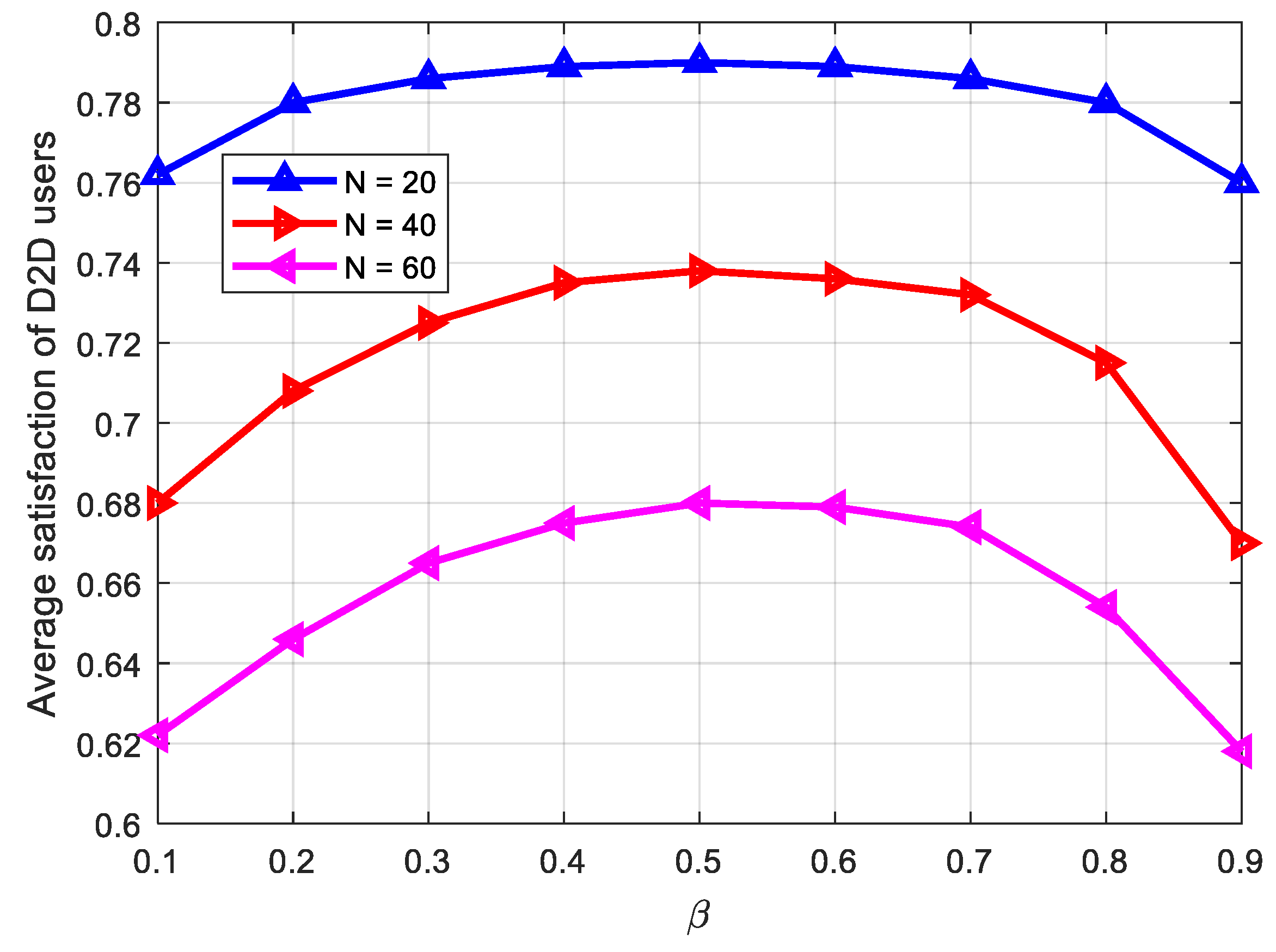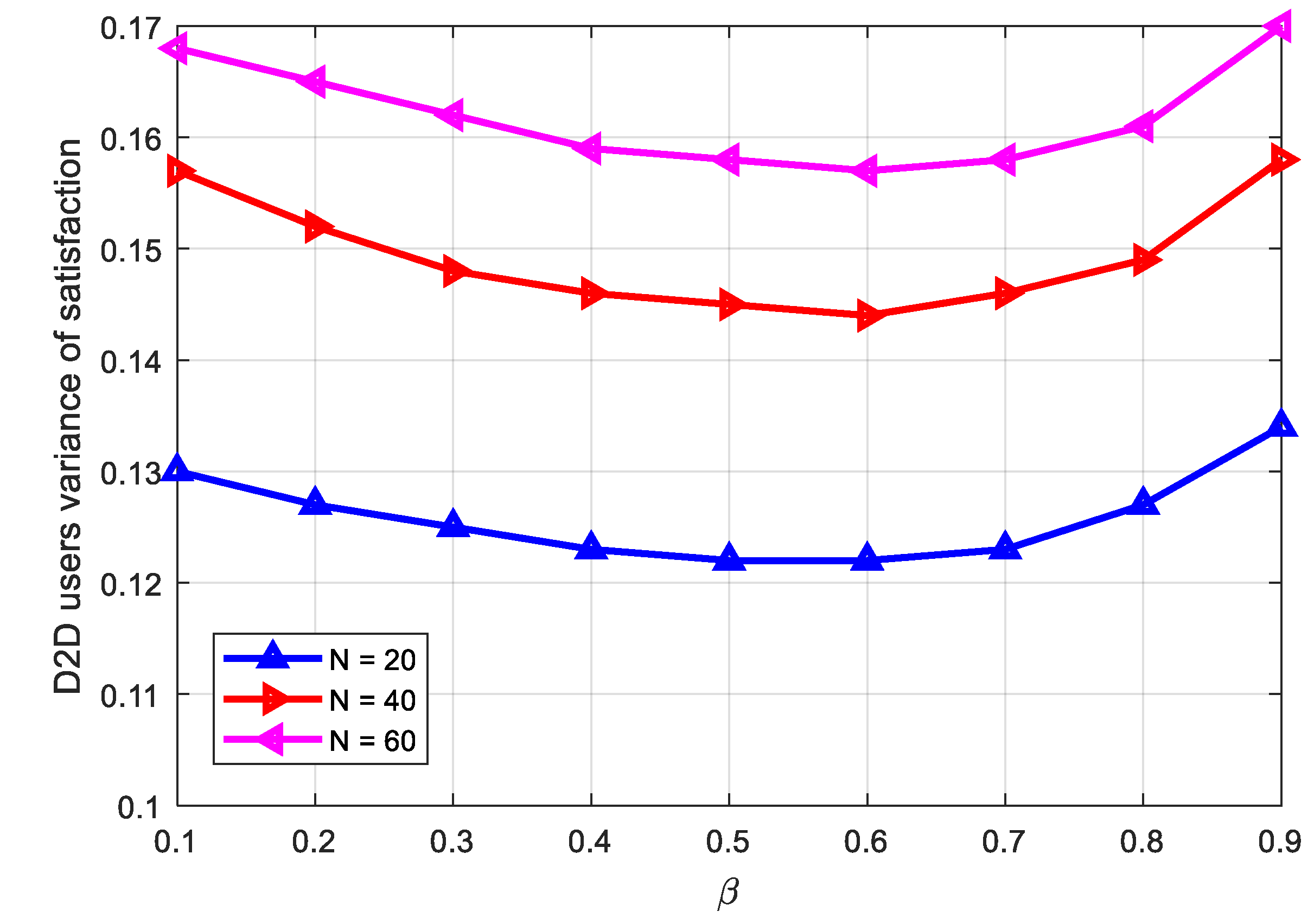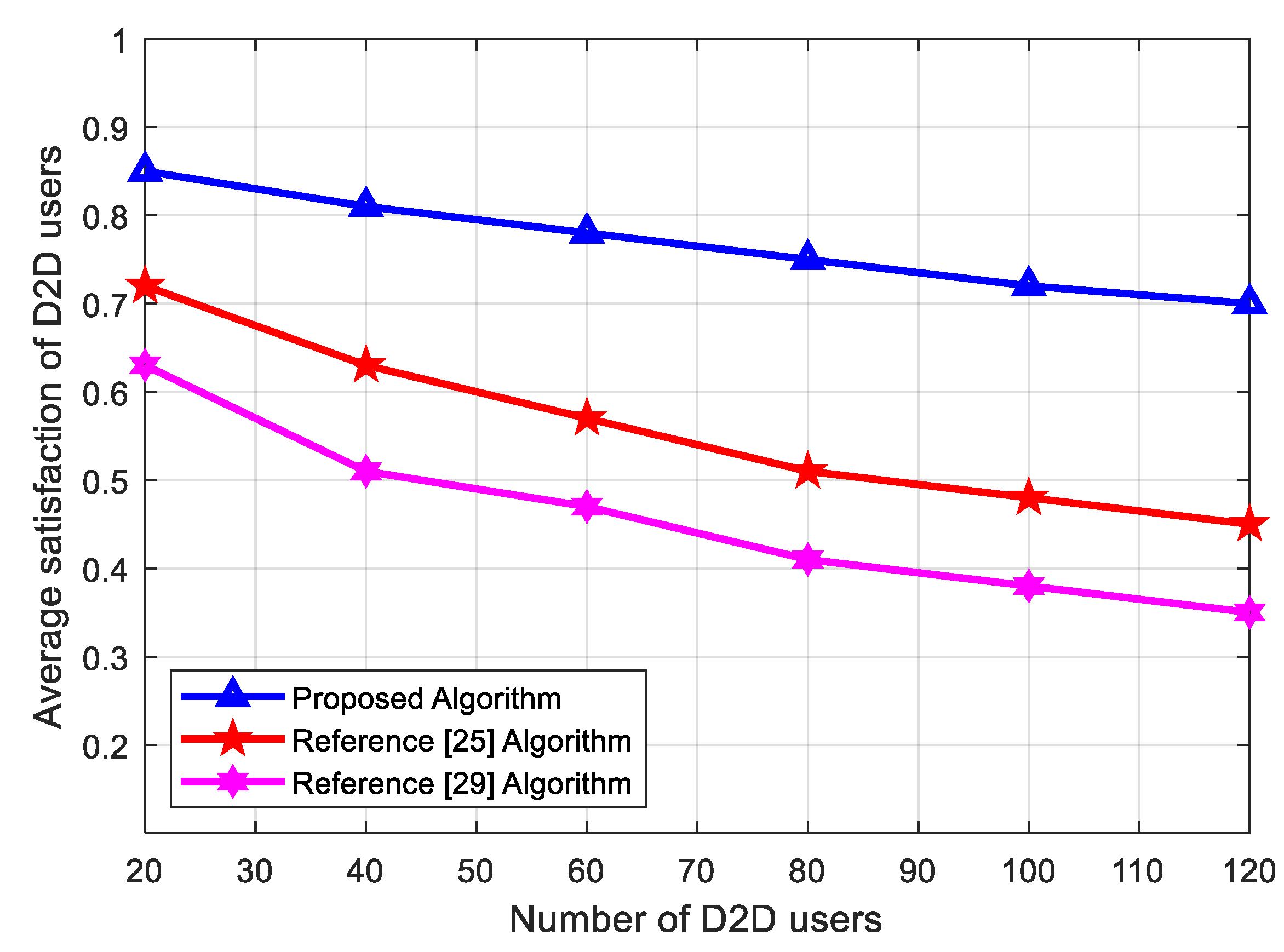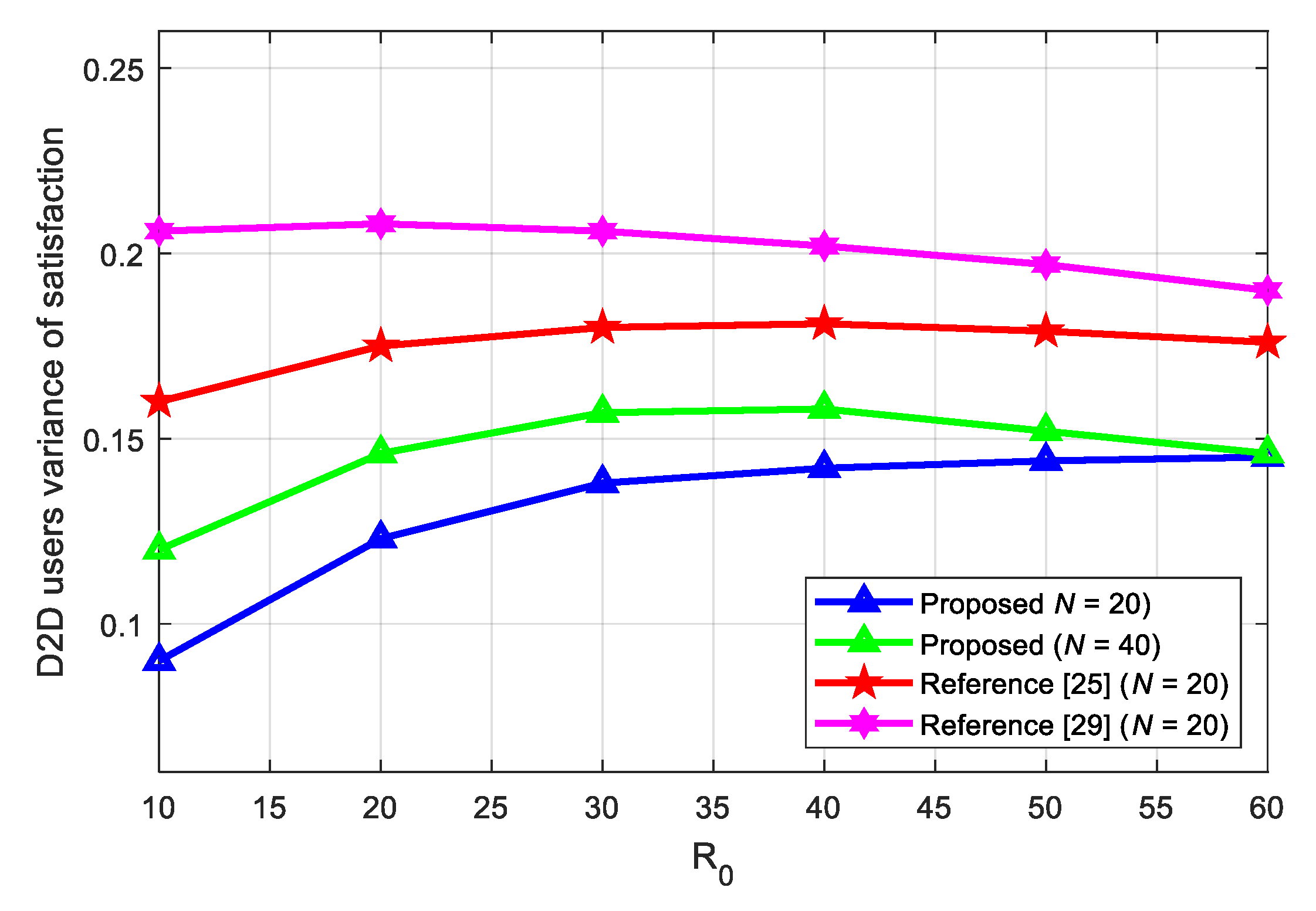Cellular-D2D Resource Allocation Algorithm Based on User Fairness
Abstract
1. Introduction
2. System Model and Problem Description
2.1. System Model
2.2. Problem Description
3. Proposed Algorithm
3.1. Establishment of D2D Inter-User Interference Diagram
3.2. List of Available Colors for D2D Users
3.3. D2D User Clustering
- For D2D users who do not meet the rate requirements, the higher the rate obtained by joining a cluster, the higher the satisfaction, the higher the priority is to join the cluster.
- The term in the numerator considers the fairness among users: the smaller the satisfaction of D2D users, the higher the priority to use the color to reduce the gap with other users.
- The cost function plus the constant in the denominator avoids the possibility that the denominator is zero. At the same time, it is cooperative. It considers the impact of the use of color on the spectrum utilization of other users and systems.
| Algorithm 1 Proposed Algorithm |
|
3.4. Signaling Overhead and Complexity Analysis
4. Simulation Results and Performance Analysis
- outage probability for cellular users
- average satisfaction of D2D users
- the variance of satisfaction of D2D users
5. Conclusions
Author Contributions
Funding
Conflicts of Interest
References
- Waqas, M.; Niu, Y.; Li, Y.; Ahmed, M.; Jin, D.; Chen, S.; Han, Z. Mobility-Aware Device-to-Device Communications: Principles, Practice, and Challenges. IEEE Commun. Surv. Tutor. 2019, 1. [Google Scholar] [CrossRef]
- Ahmed, M.; Li, Y.; Waqas, M.; Sheraz, M.; Jin, D.; Han, Z. A Survey on Socially Aware Device-to-Device Communications. IEEE Commun. Surv. Tutor. 2018, 20, 2169–2197. [Google Scholar] [CrossRef]
- Shaikh, F.S.; Weissmuller, R. Routing in Multi-Hop Cellular Device-to-Device (D2D) Networks: A Survey. IEEE Commun. Surv. Tutor. 2018, 20, 2622–2657. [Google Scholar] [CrossRef]
- Tsiropoulou, E.E.; Katsinis, G.K.; Papavasiliou, S. Utility-based Power Control via Convex Pricing for the Uplink CDMA Wireless Networks. In Proceedings of the IEEE European Wireless Conference (EW), Lucca, Italy, 12–15 April 2010; pp. 200–206. [Google Scholar]
- Singhal, C.; Swades, D. Resource Allocation in Next-Generation Broadband Wireless Access Networks; IGI Global: Hershey, PA, USA, 2017. [Google Scholar]
- Ma, S.; Li, H.; He, Y.; Yang, R.; Lu, S.; Cao, W.; Li, S. Interference Management. IEEE Trans. Mob. Comput. 2019, 18, 2019–2102. [Google Scholar]
- Saraereh, O.A.; Mohammed, S.; Khan; Rabie, K.; Affess, S.; Khan, I. An Efficient Resource Allocation Algorithm for Device-to-Device Communications. Appl. Sci. 2019, 9, 3816. [Google Scholar] [CrossRef]
- Alemaishat, S.; Saraereh, O.A.; Khan, I.; Choi, B.J. An Efficient Resource Allocation Algorithm for D2D Communications Based on NOMA. IEEE Access 2019, 7, 120238–120247. [Google Scholar] [CrossRef]
- Jabeen, T.; Ali, Z.; Khan, W.; Jameel, F.; Khan, I.; Sidhu, G.A.S.; Choi, B.J. Joint Power Allocation and Link Selection for Multi-Carrier Buffer Aided Relay Network. Electronics 2019, 8, 686. [Google Scholar] [CrossRef]
- Bakht, K.; Jameel, F.; Ali, Z.; Khan, W.; Khan, I.; Sidhu, G.A.S.; Lee, J.W. Power Allocation and User Assignment Scheme for beyond 5G Heterogeneous Networks. Wirel. Commun. Mob. Comput. 2019, 2019, 1–11. [Google Scholar] [CrossRef]
- Lee, B.M.; Patil, M.; Hunt, P.; Khan, I. An Easy Network Onboarding Scheme for the Internet of Things Networks. IEEE Access 2019, 7, 8763–8772. [Google Scholar] [CrossRef]
- Jameel, F.; Ristaniemi, T.; Khan, I.; Lee, B.M. Simultaneous Harvest-and-Transmit Ambient Backscatter Communications under Rayleigh Fading. EURASIP J. Wirel. Commun. Netw. 2019, 166, 1–9. [Google Scholar] [CrossRef]
- Saraereh, O.A.; Alsaraira, A.; Khan, I.; Uthansakul, P. An Efficient Resource Allocation Algorithm for OFDM-Based NOMA in 5G Systems. Electronics 2019, 8, 1399. [Google Scholar] [CrossRef]
- Saraereh, O.A.; Alsaraira, A.; Khan, I.; Choi, B.J. A Hybrid Energy Harvesting Design for On-Body Internet-of-Things (IoT) Networks. Sensors 2020, 20, 407. [Google Scholar] [CrossRef] [PubMed]
- Imran, A.; Zoha, A.; Day, A.A. Challenges in 5G: How to empower SON with Big Data for enabling 5G. IEEE Netw. 2014, 28, 27–33. [Google Scholar] [CrossRef]
- Kastrinogiannis, T.; Tsiropoulou, E.E.; Papavassiliou, S. Utility-based Uplink Power Control in CDMA Wireless Networks with Real-Time Services. In Proceedings of the International Conference on Ad-Hoc Networks and Wireless, Sophia Antipolis, France, 10–12 September 2008; pp. 307–320. [Google Scholar]
- Zhang, Y.; Mohsen, G. Game Theory for Wireless Communications and Networking; CRC Press: Boca Raton, FL, USA, 2011. [Google Scholar]
- Asadi, A.; Wang, Q.; Mancuso, V. A Survey on Device-to-Device Communication in Cellular Networks. IEEE Commun. Surv. Tutor. 2014, 16, 1801–1819. [Google Scholar] [CrossRef]
- Feng, D.; Lu, L.; Yuan-Wu, Y.; Li, G.Y.; Feng, G.; Li, S. Device-to-Device Communications Underlaying Cellular Networks. IEEE Trans. Commun. 2013, 61, 3541–3551. [Google Scholar] [CrossRef]
- Cai, X.; Zheng, J.; Zhang, Y.; Murata, H. A Capacity Oriented Resource Allocation Algorithm for Device-to-Device Communication in Mobile Cellular Networks. In Proceedings of the IEEE International Conference on Communications (ICC), Sydney, Australia, 10–14 June 2014; pp. 2233–2238. [Google Scholar]
- Min, H.; Lee, J.; Park, S.; Hong, D. Capacity Enhancement Using an Interference Limited Area for D2D Uplink Underlying Cellular Networks. IEEE Trans. Wirel. Commun. 2011, 10, 3995–4000. [Google Scholar] [CrossRef]
- Han, J.; Cui, Q.; Yang, C.; Tao, X. Bipartite Matching Approach to Optimal Resource Allocation in Device to Device Underlying Cellular Network. Electron. Lett. 2014, 50, 212–214. [Google Scholar] [CrossRef]
- Li, W.; Huaqing, W. Fast Pairing of Device-to-Device Link Underlay for Spectrum Sharing with Cellular Users. IEEE Commun. Lett. 2014, 18, 1803–1806. [Google Scholar]
- Xu, C.; Song, L.; Han, Z.; Zhao, Q.; Wang, X.; Cheng, X.; Jiao, B. Efficiency Resource Allocation for Device-to-Device Underlay Communication Systems: A Reverse Iterative Combinational Auction Based Approach. IEEE J. Sel. Areas Commun. 2013, 31, 348–358. [Google Scholar] [CrossRef]
- Zhang, R.; Cheng, X.; Yang, L.; Jiao, B. Interference Graph-Based Resource Allocation (InGRA) for D2D Communications Underlaying Cellular Networks. IEEE Trans. Veh. Technol. 2015, 64, 3844–3850. [Google Scholar] [CrossRef]
- Cai, X.; Zheng, J.; Zhang, Y. A Graph-coloring Based Resource Allocation Algorithm for D2D Communications in Cellular Networks. In Proceedings of the IEEE International Conference on Communications (ICC), London, UK, 8–12 June 2015; pp. 5429–5434. [Google Scholar]
- Wang, B.; Chen, L.; Chen, X.; Zhang, X.; Yang, D. Resource Allocation Optimization for Device-to-Device Communication Underlying Cellular Networks. In Proceedings of the IEEE 73rd Vehicular Technology Conference (VTC Spring), Budapest, Hungary, 15–18 May 2011; pp. 1–6. [Google Scholar]
- Cederbaum, I. Some Applications of Graph Theory to Network Analysis and Synthesis. IEEE Trans. Circuits Syst. 1984, 31, 64–68. [Google Scholar] [CrossRef]
- Checco, A.; Leith, D.J. Fast, Responsive Decentralized Graph Coloring. IEEE ACM Trans. Netw. 2017, 25, 3628–3640. [Google Scholar] [CrossRef]
- Wang, R.; Wu, J.; Yan, J. Resource Allocation for D2D-Enabled Communications in Vehicle Platooning. IEEE Access 2018, 6, 50526–50537. [Google Scholar] [CrossRef]
- Braz, D. New Methods to Color the Vertices of a Graph. Commun. ACM 1979, 22, 251–256. [Google Scholar]









| Algorithm | Signaling Overhead/Complexity |
|---|---|
| With Proposed Algorithm | |
| Without Proposed Algorithm |
| Parameter | Value |
|---|---|
| Number of cellular users | 10 |
| Subchannel bandwidth | 1 MHz |
| Cell radius | 200 m |
| Distance between D2D user pairs | 20 m |
| Base station total transmit power | 46 dBm |
| D2D user transmit power on the subchannel | 24 dBm |
| Path loss constant | 0.01 |
| Path loss index | 4 |
| Minimum rate requirements for cellular users | 2 Mbit/s |
| Noise power | −104 dBm |
| Speed requirements for D2D users | Obey uniform distribution on [0, ] Mbit/s |
© 2020 by the authors. Licensee MDPI, Basel, Switzerland. This article is an open access article distributed under the terms and conditions of the Creative Commons Attribution (CC BY) license (http://creativecommons.org/licenses/by/4.0/).
Share and Cite
Alsharfa, R.M.; Mohammed, S.L.; Gharghan, S.K.; Khan, I.; Choi, B.J. Cellular-D2D Resource Allocation Algorithm Based on User Fairness. Electronics 2020, 9, 386. https://doi.org/10.3390/electronics9030386
Alsharfa RM, Mohammed SL, Gharghan SK, Khan I, Choi BJ. Cellular-D2D Resource Allocation Algorithm Based on User Fairness. Electronics. 2020; 9(3):386. https://doi.org/10.3390/electronics9030386
Chicago/Turabian StyleAlsharfa, Raya Majid, Saleem Latteef Mohammed, Sadik Kamel Gharghan, Imran Khan, and Bong Jun Choi. 2020. "Cellular-D2D Resource Allocation Algorithm Based on User Fairness" Electronics 9, no. 3: 386. https://doi.org/10.3390/electronics9030386
APA StyleAlsharfa, R. M., Mohammed, S. L., Gharghan, S. K., Khan, I., & Choi, B. J. (2020). Cellular-D2D Resource Allocation Algorithm Based on User Fairness. Electronics, 9(3), 386. https://doi.org/10.3390/electronics9030386






